
OVERVIEW
MANAGEMENT
PERFORMANCE
POSSIBILITIES
CAPITALS
ACTIVITIES
ACTORS
BURGESS

| |||||||||
| HOME | SN-BRIEFS |
SYSTEM OVERVIEW |
EFFECTIVE MANAGEMENT |
PROGRESS PERFORMANCE |
PROBLEMS POSSIBILITIES |
STATE CAPITALS |
FLOW ACTIVITIES |
FLOW ACTORS |
PETER BURGESS |
| SiteNav | SitNav (0) | SitNav (1) | SitNav (2) | SitNav (3) | SitNav (4) | SitNav (5) | SitNav (6) | SitNav (7) | SitNav (8) |
| Date: 2025-04-07 Page is: DBtxt001.php txt00016410 | |||||||||
People: Adam Horowitz |
|
Burgess COMMENTARY Peter Burgess |
adam horowitz
Author’s Note: It’s strange to tell a story in the middle of living it. But that’s what this is; a mid-journey reflection, a brief pause to retrace the path and share a glimpse of the surroundings en route to somewhere not yet known. In December 2018, one month in to a six-month “pilot residency” at a convent in California, I sat down to write a year-end note to share with family and friends. It quickly became clear that it would take more than just an email to explain where I was, and why. This is what emerged. My hope is that this writing might somehow be engaging and informative for folks who know nothing about religious life as well as to sisters and others who live it or know it well. Mostly, this is an invitation to join in an unfolding journey and a growing conversation, about what’s needed, what’s possible, and what’s being called forth at this moment in time. My deepest thanks to dear friends and fellow travelers on this unlikely journey of Nuns & Nones, to the Sisters of Mercy and staff at Mercy Center for friendship and hospitality, and to my family for not thinking I’d gone off the deep end when I told them I was moving into a convent. Thanks to Christina Tran for the idea and design chops to make this writing come to life in this format. February, 2019 Mercy Center, Burlingame, CA2018-11-29 16.25.17 HDR copy-crop.jpg What’s a Nice Jewish Boy Doing in a Convent? Nuns, Millennials, and the Call to Community by Adam S. Horowitz The week I moved into the convent was the week that the sky turned dark with smoke. California was burning at a record-breaking scale, the city of Paradise decimated with untold numbers of lives lost, and here I was, driving in the direction of the fire all the way from New Mexico, in a car loaded with my belongings and two of my dearest friends. It’s always an odd time to move into a convent, as a young Jewish man. Doing so under an apocalyptic sky thick with ash made it especially so. After three days of driving we reached the formidable entry gate to the Sisters of Mercy campus in Burlingame, California, climbed the winding driveway past ancient oak trees, and parked in front of the labyrinthine four-story building that would be our home for the next six months—and which had been home for more than sixty years for many of the Catholic nuns, or “women religious,” who would now be our neighbors. We were greeted in the parking lot by Mel, the security guard, who offered a few riddle-like stories and wished us luck, and at the front desk by Valerie, who assured us that the sisters had prayed away the ghost that used to dwell in the mansion further up the hill. As we began unloading the car in the dark, Sister Joan Marie emerged to greet us with hugs, a hearty “welcome home!” and a bottle of a wine. Mercy hospitality already on full display. Like many of the 400 orders of Catholic Women Religious in the U.S., the story of the Sisters of Mercy is one of courageous women, profound humility and commitment, and outsized impact. Heeding the call of their Irish foundress, Catherine McAuley, to “be shining lamps giving light to all around,” the Sisters of Mercy have spent 187 years living in communities of contemplation and social action, responding to unmet needs in society with a radical spirit of mercy and compassion. The first six Sisters of Mercy in the U.S. arrived in Pittsburgh in 1843, where—within just a few years—they fundraised for, built, and staffed a hospital, a school for young women, an orphanage, and more. Within the next decade new communities opened in New York City, Chicago, Little Rock, San Francisco, and beyond, where Sisters, often joining in their teens, rallied to meet whatever needs they encountered. Cholera outbreak? Start a hospital. Civil War? Head out to the battlefield to tend to soldiers on both sides. Housing crisis? Start one of the nation’s largest affordable housing organizations. A concise history of the order would fill several books—as could tales from the Burlingame campus alone. I can’t and won’t try to do justice to that story here. Let me just say that I don’t know of any other community praised by Abraham Lincoln, sung about by Leonard Cohen, and able to build some of the largest-scale educational, healthcare, and housing infrastructure in the country. Currently, there are more than 2,900 Sisters of Mercy in the Americas and more than 9,000 from various congregations of the Sisters of Mercy worldwide. Their ministries vary, but all Mercy sisters are united in their vows of poverty, chastity, obedience, and service as well as their focus on five “critical concerns”—care for the Earth, immigration justice, nonviolence, racial justice, and women’s issues. Like most communities of women religious in the U.S., the Sisters of Mercy have fewer and fewer women (“novices”) entering the order. Across the U.S., the average age of a Catholic nun is 80. 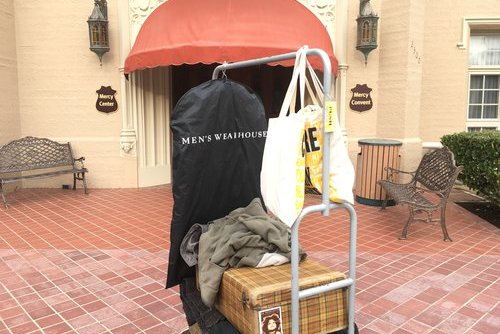
Moving in to Mercy Center. November, 2018. Photo by the author. Sisters are used to surprise guests. Many orders started orphanages after newborn babies were left on convent doorsteps. In Burlingame, the Sisters of Mercy declared sanctuary in the mid-80s and took in many refugees and asylees in times of crisis. But a group of “millennials”? This was certainly new, and unexpected. As one sister put it, “you know it’s the work of Spirit when it comes through the side door.” Sometimes you pray for new novices and three bearded men show up on your doorstep on a smoky November night. The story of how and why I arrived to live in this convent for six months is surely bigger than one I can tell here—or even fully understand at this moment. Like any story, it’s part of a much larger and more mysterious puzzle of which the teller can see only a few pieces. What follows, then, is just an initial attempt to assemble some of the clues from my own experience. *** A Wandering Jew and a Wondering Reverend I’ve been itinerant for the last two and a half years, with no fixed address or apartment to return to, much of it due to “my secret life with nuns.” But the itinerancy precedes this journey with the sisters. Indeed, it may be as deep as DNA. My ancestors crossed borders just as frequently as borders crossed them, descendants of millennia of “wandering Jews” in search of a promised land. Most of my great-grandparents sought that promised land in the U.S., leaving the “Old Country” in Eastern Europe by boat and then hopping aboard a multi-generational assimilation train. Far removed from the daily religious practice of the Torah-carrying ancestors who migrated here, the Judaism I inherited was secular and cultural, rooted more in the values of family, generosity, education, and border-crossing, than in any form of religious or spiritual practice. Mine was the kind of Judaism where you learn enough to pronounce Hebrew letters and chant with a wobbling, cracking voice, at the awkward age of thirteen, to a room full of everyone you know. After the bar mitzvah, I was more or less “done.” Rather than an initiation into meaningful Jewish adulthood, responsibility, and spiritual deepening, this ritual was the last task on the checklist of perfunctory Jewish education, before continuing on a secular path. Judaism as vestigial organ rather than beating heart. And yet, the wandering impulse does not easily fade in a generation or two. Nor, perhaps, does the ancestral memory of the village, the desire to root in a wisdom tradition, or the sense that life should be infused with ritual and spiritual practice in community. Five years ago, while living in New York City, I set out on a roadtrip with friends to visit intentional communities that were spiritually grounded and actively socially-engaged, not isolated unto themselves. “Not Your Grandma’s Commune,” we called our planning document. In visiting Quaker Villages, Jewish social justice houses, urban dojos, and more, we were looking for viable models of community living that didn’t privatize love, keeping families apart in suburban domestic oblivion. I was hooked by the (un-American?) dream of taking down the white picket fences and rebuilding the village heart. The path to getting there was unclear, but I yearned to be a part of some kind of intentional community pulsing with imagination, communality, and social action. In 2015, I left New York City abruptly, in what felt like a self-initiated intervention (or inner-vention). City life was dynamic, but I had the hunch that something was calling me elsewhere. I knew I wouldn’t be a “lifer” in the city, and would surely leave at some point—so, why not now? Shortly before leaving, over dinner with friends, I recall sharing with some sadness that it felt like the only option there, or in any new place I might move, was to lease an apartment. As the word rolled off of my tongue I could hear why. Why rent an apart-ment, to be set apart? At the time, I had no idea I’d soon be spending so much time in convents—derived from the word convenire, to come together. I returned to Santa Fe, New Mexico, the place of my birth and the most familiar landscape of my life. Though surrounded by vast skies and ancient red-rocked mountainsides, I was still tethered to wifi, submitting myself to long digital workdays, shepherding the organization I’d started a few years before, the U.S. Department of Arts and Culture. I yearned for more in-person community and to explore the mystical, contemplative, and social justice underpinnings of the Jewish tradition that had otherwise been reduced to good food, a reverence for learning, and a couple of annual holidays. But, nonprofit work-life had me on a different kind of treadmill. Through an introduction from a mutual friend back east, I connected with Wayne Muller, an ordained reverend and author in his mid-sixties, who turned out to be a neighbor, just a few doors down from my Santa Fe perch. Wayne was gregarious, eccentric, and full of theological insight; we struck up an easy friendship and began taking meandering walk-and-talks through the neighborhood. One cool spring day in 2016 we wandered and wondered aloud about the kind of social, communal, and spiritual infrastructure needed for welcome, refuge, and belonging in the 21st century. We talked about the ubiquitous role that YMCAs used to play as places of hospitality for newcomers, and about cultural centers and monasteries—and at some point in this conversation, Wayne brought up the sisters. Over decades of writing, speaking, and ministering, Wayne had developed friendships with Catholic women religious and had recently returned from Chicago where a group of sisters shared with him their story of diminishing numbers and the five-story convent they were preparing to raze. That loss of community and of community space seemed unnecessary, given how many younger folks both Wayne and I knew who were hungry for spiritual mentorship, models of alternative community, and rhythms of life that balance contemplation and social action. I’d never met a sister, but the more that Wayne shared about their lives, the more I could hear the resonance with the questions underlying that roadtrip years prior and with the questions I knew so many of my peers in their late 20s and early 30s were grappling with. The more we discussed it, the more there seemed to be a potential synergy between nuns and millennials, including the so-called “nones”—folks who might check “none of the above” on a list of religious affiliations. 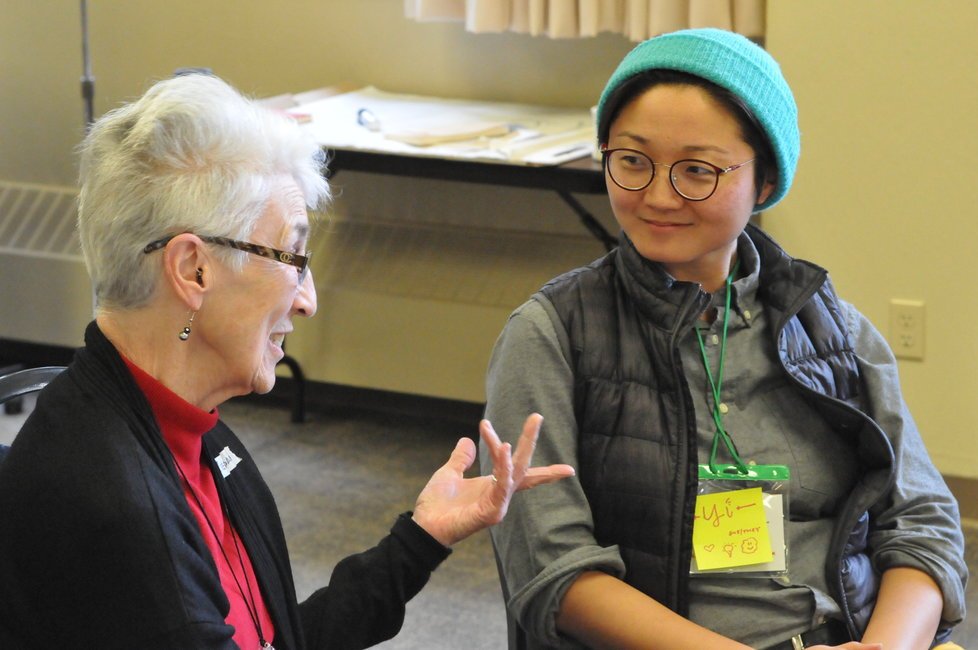
Yi Zhang and Sr. Rosann Fraher, RSM, at a Nuns & Nones gathering. Photo by Sarah Bradley. Here’s how we later worded it on the Nuns & Nones website: Across the U.S., Women Religious from over 400 communities are serving the unmet needs of so many who live on the margins of society, with a spirit of radical compassion. They have developed a powerful, robust infrastructure, building and serving community across the U.S. and the world. Yet their own religious communities face declining membership, invoking poignant emotional, existential, spiritual questions about the future of their missions, lineages, spiritual and worldly physical assets. Millennials have the largest percentage of religiously unaffiliated members of any age group. Many of these spiritual but not religious 'Nones' are actively seeking and creating communities of purpose, belonging, and service outside of religious institutions. Like the sisters, they are called to serve something larger than themselves, with a willingness to leap, in faith they will find their way as they go, grounded in an unshakable ethos of radical invitation and welcome. Both groups are asking “what’s next?”—listening closely for what wants to emerge at this critical moment—each offering some of the wisdom, inspiration, energy, commitment, and deepening community the other seeks. What learnings, what untapped mutual resources might be discovered, and set free, to serve the unmet needs in the world, through an alliance of these two inspired and inspiring communities? We decided to ask these questions by bringing the two groups together. Wayne reached out to a few sisters he knew to bounce the idea off of them. Was it crazy? “Yes,” he heard in response from some, “and we’ll be there!” I shared with peers who, it turned out, were similarly captivated by the idea. Once a few sisters had indicated they’d join the first gathering, others began reaching out to ask if they might attend, including several past presidents of the Leadership Conference of Women Religious (LCWR), the association of Catholic women religious leaders that represents nearly 80 percent of the approximately 45,600 sisters in the United States. We connected with our mutual friends at the Harvard Divinity School to schedule meeting space for a few days. By design, our gathering would coincide with a meeting that a group of millennials would already be attending. Although we didn’t have funding, Wayne promised to refund sisters’ airfare from his own credit card. It seemed just improbable enough to be worth trying. *** The Beginnings of Nuns & Nones We probably made a dozen trips up and down the elevator to our meeting room, bringing in potted plants, snacks, drinks, posterboards, and decorations, to brighten that bleak December day in Cambridge, Massachusetts. Wayne was determined to make sure the vibe was homey, not institutional, and had purchased enough supplies to last a week, though we would only be there for two days. Several sisters arrived early, of course, as we were still putting the room together. Within moments of meeting them, I got the sense that this would not be anything like what I had imagined. Sure, I’d begun to read up on the history of women religious, but the first interactions made it clear that this was actually going to be quite fun—a time of deep presence, humor, and joy. Sr. Sue Mosteller, in her 80s, who had traveled all the way from Toronto to be there, hugged me so hard upon first meeting that I nearly lifted off the ground. There was a sense of giddy anticipation and uncertainty in the room as about a dozen millennials and a dozen sisters arrived. And, yet, it did not take long at all to move from the warm buzz to a depth of silence and truthtelling, as we took a shared breath and began to go around the circle responding to a first prompt: “What is moving in you? What’s something alive, that you’re grappling with or wondering about at this moment?” 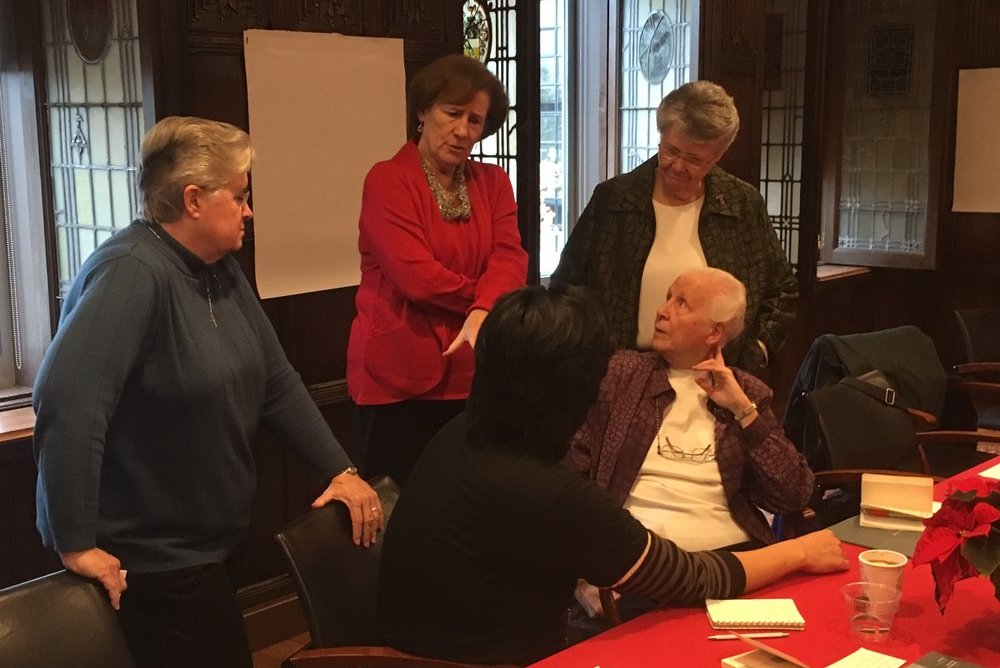
Sisters at the first Nuns & Nones gathering at the Harvard Divinity School in Cambridge, MA. November, 2016. Photo by the author. It hadn’t even been one month since the 2016 presidential election, and we were all still reeling with the implications. Yet, while tinged by the historical moment, this circle wasn’t speaking to the minutia of newspaper headlines. Collectively, our wonderings told a much longer and deeper story, of human vulnerability and yearning, the presence or lack of caring connection and community, leadership in the face of uncertainty and risk, the quest for justice, the dance between the urgency of now and the long view, commitment and freedom, how to listen for one’s call in times such as these. By the time we had completed a first go-around, it was as if we were already family. Both sisters and millennials had echoed each other’s words and sentiments, enriching one another’s journeys simply by sharing our honest questions and unknowings. Sr. Mary Dacey put it succinctly: “We have so much more in common here, than could ever divide us.” This was the first two hours—and we had two more days together. We were hooked. It was already “worth it.” Whatever else happened from here would just be continued blessing. The dominant narrative of our time is one of division and polarization. But there’s another story, less frequently told, but no less alive and certainly more hopeful. Over the last two years, I’ve experienced, again and again, a sense that the rapid pace of change and scope of need in the world is enabling a bridging of difference and a quickening of relationship. People are being called to stand at the outer edge of their traditions and identities, to reach out with others doing the same, and to take some next step together toward something new. For many of us so-called “millennials” in the circle, there was a sense that the women we were meeting were almost the antitheses of the newly elected ego-inflated misogynist and the system that created him. These were powerful women leaders who’d taken a vow of poverty, who lived, discerned, and shared in community, offered love and care to those who needed it most, created vast infrastructure to meet unmet needs, and who were constantly and collectively evolving their communities and institutions. What other institutions and communities were so completely led by women? And what might the world look like with more of such leadership at the helm? The story of that first gathering could itself make a small book; the transcript alone is a riveting read. And the same could be said of every single gathering that followed. Going into this first circle we had no idea what would happen, but one of the very clear outcomes after two days together was the expressed desire and mandate to keep coming together. At this first gathering, sisters and millennials had come from all across the country. Everyone left asking “how do I meet the nuns, or the nones, near me?” Wayne and I didn’t know how or where or when, but we knew upon leaving this hopeful encounter that we would soon be hosting more. 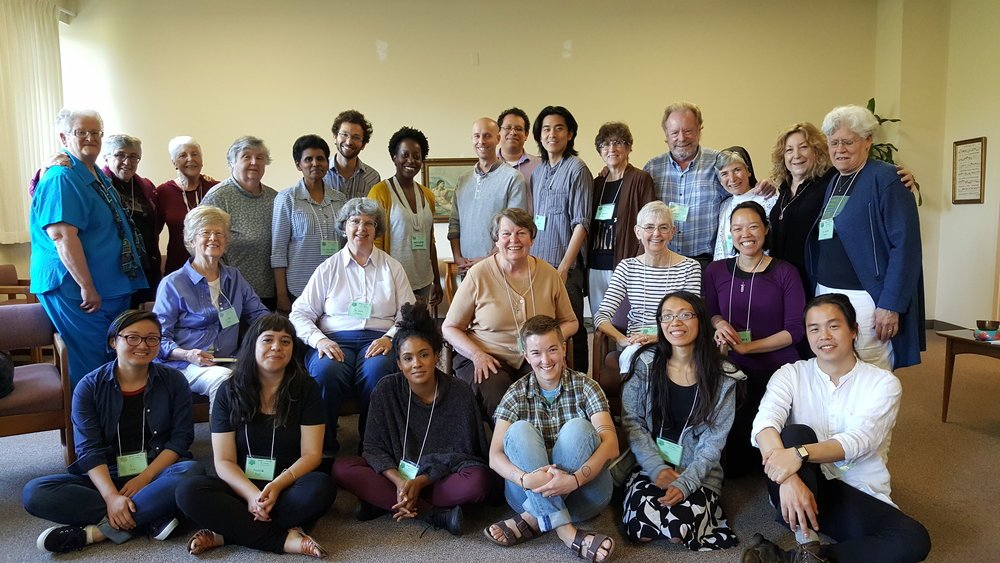
Group photo from the first Bay Area Nuns & Nones gathering. May, 2017. *** Meet the Sisters For readers who are less familiar with sisters, as I was until recently, let me pause the narrative for some additional context—along with a few obvious disclaimers: I am not a sister; I am not a historian of religious life; and generalizing about sisters is about as unreasonable an undertaking as generalizing about millennials. There are some 400 orders of women religious in the U.S., and within each order there are as many kinds of sisters as there are members of the community. As I’ve heard more than once: “you meet one Sister of Mercy, you meet one Sister of Mercy.” With that in mind, here’s just a bit of context about some of the women I’ve had the privilege of meeting over the last few years. If you’re holding the image of a cloistered nun wearing a habit, praying quietly behind thick convent walls, toss it out. Conjure, instead, images of determined activists risking arrest at protests, heads of major universities, hospitals, and social service organizations, representatives to the United Nations, teachers, professors, artists, permaculturists, scientists, nurses, doctors, social entrepreneurs, young sisters in grad school as well as seventy/eighty/ninety-year-old women who “retire” again and again, only to start new ministries, join boards of international organizations, and continue to serve those in need right where they are. Picture women who continue to learn new languages, engage in lifelong anti-oppression training, accompany folks on the streets, in courts and prisons, and who might return to university at age fifty or sixty to get a law degree or PhD. And picture women who do this while living in self-governing, income-sharing communities, navigating a church hierarchy run by men and mired in scandal, and all without ever tooting their own horns. On the one hand, given the scope of their “good works” it’s a wonder that more people don’t know about the lives and impact of women religious in the U.S.—beyond what they may have seen in the film Sister Act. On the other hand, it makes total sense; sisters are committed to being of service, and not to being recognized or celebrated for the work they do—to the chagrin of two millennial attendees of a Nuns & Nones gathering in Kalamazoo who proclaimed that the sisters need a “rebranding” campaign. To truly get a sense of who a sister is, it’s good to ensure you’re also sitting with another member of the community who can fill in the details her friend is too humble to share, or to have long enough to draw out the fuller story through persistent inquiry. I once sat with a sister who, only after my constant questions about what she’d been up to in the last year, revealed that she’d recently helped hand the Mayor of New Orleans a $148 million dollar government check for Katrina relief that otherwise would have been left off the table. On the side of running a shelter for undocumented youth. No big deal. 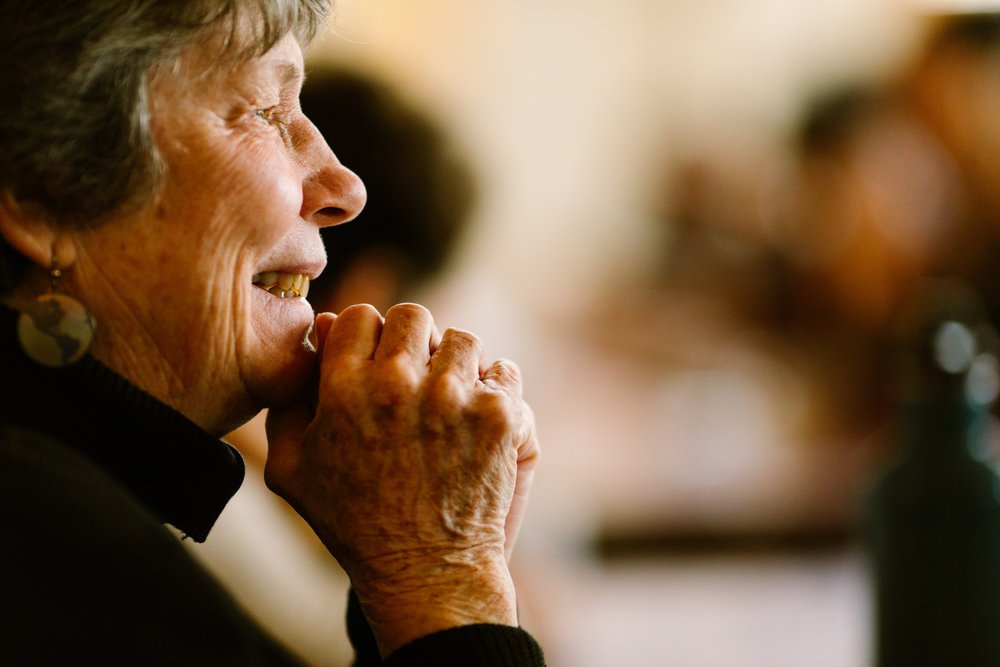
Sr. Judy Carle, Sister of Mercy. Photo by Rhino Media. But it’s not just the work they do that leads to jaw-dropping moments in our gatherings, it’s how they do it. Show me another community that gathers all together every six years in a roomful of hundreds of people, to collectively rewrite a mission statement—and succeeds at the task. Where salaries are pooled across the community and “retirement” is just code for “not getting compensated anymore.” Where you can lose your job for political reasons or decide to switch careers, with a sabbatical in-between gigs, because the community has got your back. Where a significant percentage of the community ends up in democratically elected leadership at some point. Where a spiritual life binds members together, but where each member is fully supported in following her own vocation. Sisters are not propped up financially by the church. Their hospitals, schools, shelters, advocacy and justice organizations, farms, programs for people of every walk of life, as well as their own convents, motherhouses, and assisted living centers were all built by sisters who fundraised and pooled resources. And prayed, of course. None of this would have been possible, they would hasten to add, without the support and guidance of Spirit and the imprint and inspiration of their loving, pragmatic, determined, and energetic foundresses. There are two, identity-defining historical turning points that come up at nearly every Nuns & Nones gathering, without which it’s hard to understand this moment in religious life. Ask a group of sisters what happened during Vatican II and you’ll feel the energy pick up in the room as if the windows were thrown open and a gust of wind blew through. Indeed, that was the feeling for many when in 1962 Pope John XXIII and the Vatican Council instructed women religious to revisit their founding stories and to take seriously the task of renewing and revitalizing their charisms. Charism refers to that essential gift, the natural quality and purpose, of each religious community, as bestowed by its foundress. Deeper than a mission or vision statement, the charism is the heartbeat of the community, its reason and way of being. For the Sisters of Mercy, the charism is, of course, mercy—turning one’s heart to the misery in the world and responding with compassion. The Dominican Sisters explain one element of their charism as “reading the signs of the time.” Other orders may name education or work with the homeless or any number of more specific manifestations of charism. In reexamining their founding stories and intentions, sisters got back in touch with the more radical, action-oriented roots of their tradition. In many communities, the black and white habits came off and the doors opened wide. Sisters became less cloistered, often less visually identifiable, and much more present in the world. Beyond the traditional vocations of nurses and teachers, they started new organizations, joined marches and protests in the streets, got degrees and expanded their own theological horizons. Within their communities, sisters developed more horizontal leadership structures, along with a deepening commitment to contemplative practice and collective discernment. During these tumultuous years of change, many sisters left religious life. 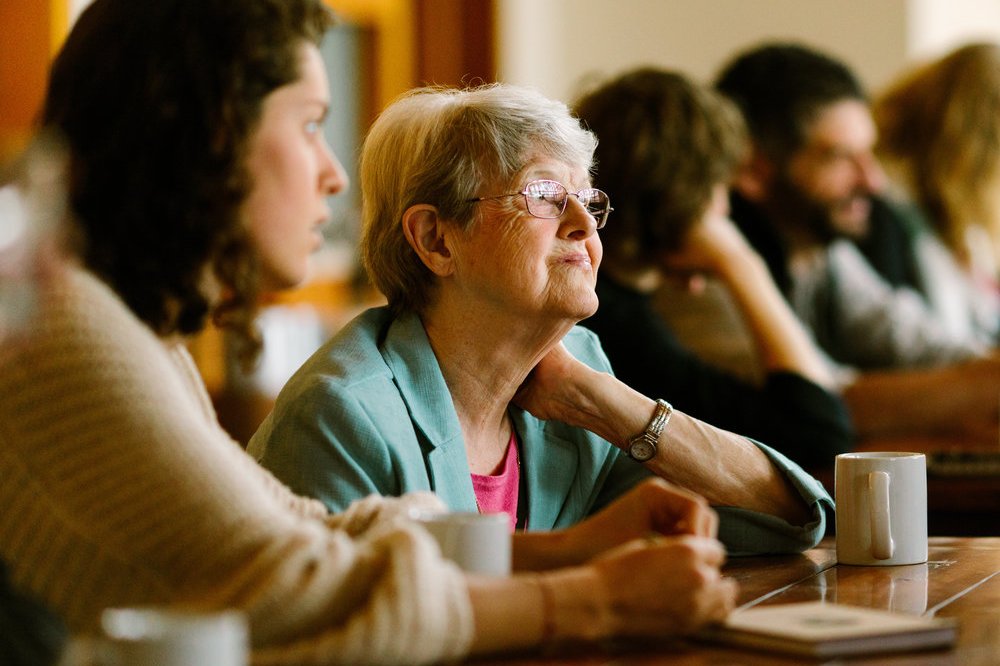
Sr. Barbara Hansen, OP, during breakfast at a national Nuns & Nones gathering at the Fetzer Institute. Photo by Rhino Media. Over one dinner conversation about Vatican II, a group of sisters shared unexpected evolutions: one adopted Buddhist practice, another embraced liturgical dance, another found herself, years later, outside of a cathedral protesting a visit from a conservative pope. Energized by the possibilities, eager to serve, and liberated from some of the more dogmatic and isolating aspects of their previous lives, sisters took seriously the charge of taking a prophetic stance—in the world writ-large, and within the institutional church. Four decades later, under the leadership of Pope Benedict XVI, it began to seem as if the Vatican regretted having asked women religious to revisit those more radical roots. The freedom and autonomy exercised by certain communities was more than the Church had bargained for. And here begins the second turning point that comes up in every Nuns & Nones gathering. Asserting that women religious in the U.S. had been unfaithful to Church doctrine, the Vatican began, in 2009, a six-year investigation of the LCWR (Leadership Conference of Women Religious), the leadership body representing some 50,000 women religious. The Vatican’s “Congregation for the Doctrine of the Faith” declared that some of the speeches and materials shared at LCWR assemblies were not theologically sound. Women religious were accused of not speaking out against homosexuality and abortion, and for sometimes taking stances against church teachings or for not distancing themselves far enough from those who did. Simultaneously, the Vatican launched a second probe, to investigate all women’s orders in the U.S. based on reports—according to the cardinal heading the committee—of “a certain secularist mentality that has spread among these religious families, perhaps even a certain ‘feminist spirit.’” In a move that was simultaneously heartbreaking, confusing, frustrating, and insulting to tens of thousands of women who’d dedicated their entire lives in service to the church, the Vatican assigned men to investigate and “assist” the women in orienting more “faithfully” to the teachings. Every time the doctrinal investigation story comes up in a gathering, it becomes a learning laboratory in moral leadership. How did the LCWR succeed in holding dynamic tension with diplomacy, grace, and integrity? How does a group that large navigate impasse and difference, maintaining trusting relationship among its own members and also with the larger institution calling it into question? What are the lessons we can all learn about patience, collective discernment, and solidarity in a time of crisis and unmooring? The sisters drew deep from their decades of practice in collective discernment and prayer. (It helps, a sister explained at our first Nuns & Nones gathering, when you start conference calls in a few minutes of silence.) They also called upon an in-house bench of expert facilitators, negotiators, lawyers, communications professionals, theologians and more, with a shared commitment to engage in diplomacy over public debate. Thousands of lay people came to the sisters’ defense—often to the sisters’ surprise—writing letters, joining in protests, showing up for the women who at some point had showed up for them. This six-year long journey, complete with investigative in-person visits to many communities of women religious in the U.S., was profoundly taxing—but it was also strengthening. Sisters emerged more unified, more visible, and even clearer as to who they were and what they stood for. Sisters involved in leading the LCWR during that period, never ones to refrain from offering a gift of light amidst darkness, even decided to publish a book on some of the leadership lessons from their experience. For a generation of younger activists grappling with how to organize with broad coalitions, how and when to stay in relationship with problematic political, social, or religious institutions, and how to stay in it for the long game without burning out, Sisters have much to offer. 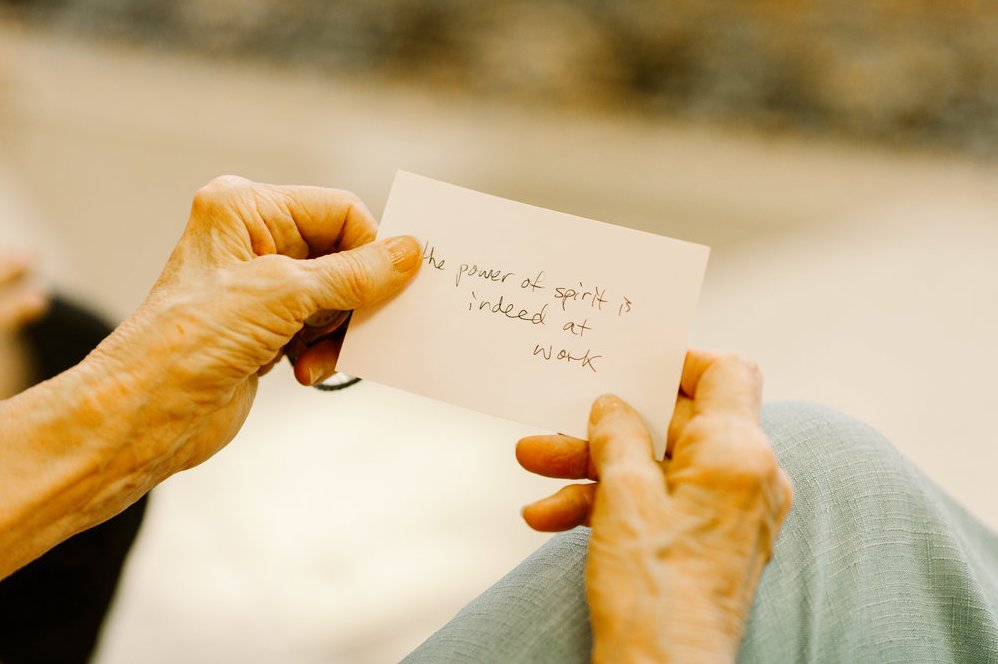
Participants hold notecards with phrases spoken during a Nuns & Nones gathering. Photo credit: Rhino Media 
Participants hold notecards with phrases spoken during a Nuns & Nones gathering. Photo credit: Rhino Media *** “Behold, I am doing something new…” On we went, the older UCC Reverend and the younger Jewish organizer, gathering with nuns and “nones” at convents and retreat centers across the country. We’d somehow convinced each other to try four more of these gatherings in 2017, riding on frequent flier miles and the goodwill of retreat centers who would front the initial costs of gathering (and a prayer that we’d find funding to reimburse costs afterward). In advance of each, Wayne would speak with and invite sisters, and I would do the same with millennials, in search of peers willing to spend two days in a dialogue circle with Catholic nuns. Another millennial organizer, Katie Gordon, started a group on her own in Grand Rapids, Michigan—which began meeting every other week—and then joined in the national efforts as well. We worked to curate groups of people who came from many different kinds of backgrounds, but shared a disposition toward curiosity and openness. Might sound like a tough sell—two days with nuns—but a surprising range of young folks responded with an eager “yes” to the invitation. We’ve had Buddhists, lapsed and practicing Catholics, Muslims, women seeking ordination, Christians of all sorts, United Universalists, Jews, atheists, pagans, seekers, mystics. (The term “nones” offered a clever rhyme, but was only partially reflective of who was coming in the door.) We’ve had first generation immigrants, white folks, people of color, queer folks, trans folks. We’ve started gatherings with preferred gender pronouns. (“Oh, ‘they!’” one sister in St. Louis remarked. “I wish we’d had that when I was younger.”) We’ve had social workers, activists, nonprofit leaders, artists, social entrepreneurs, students, and educators, working across sectors, but united in a desire to explore different ways of living in community and to offer their gifts to heal, serve, and work toward justice. 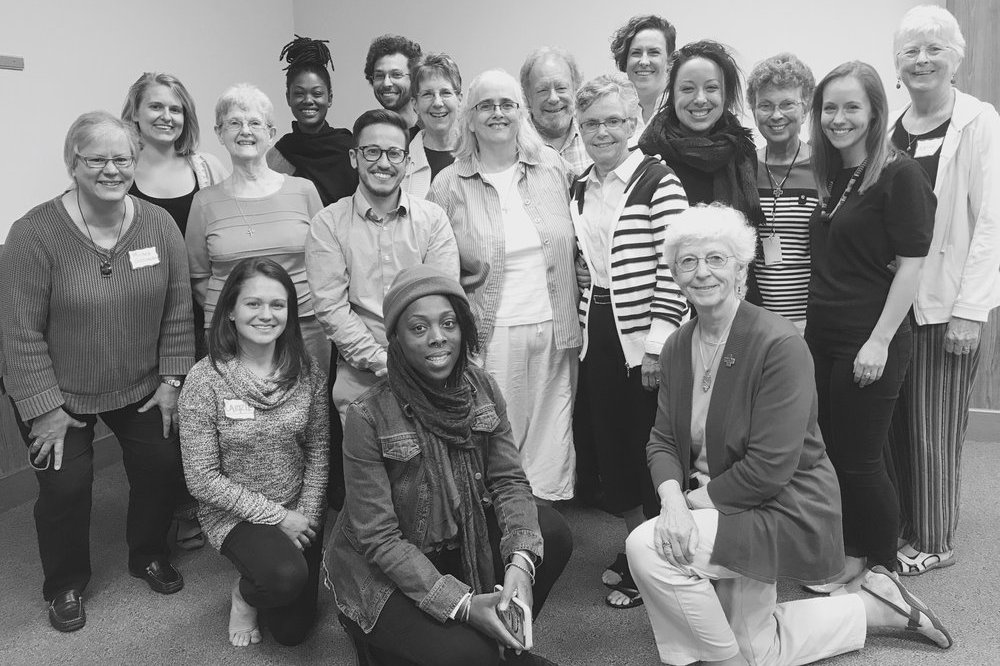
Kalamazoo Nuns & Nones gathering. At each of our two-day gatherings we offered up a simple four-part agenda: 1) an opening circle for sharing our deepest, most alive questions and wonderings, 2) “Meet the Sisters” — an opportunity for sisters to share their lives, callings, and identities, individually and collectively; 3) “Meet the Millennials” — an opportunity for the younger folks to share their lives, callings, and identities, individually and collectively; and 4) What do you want to do next? We sprinkled our time together with poetry, silence, walks in nature, and good food. Each time, the two days would fly by. In the San Francisco Bay Area, Kalamazoo, Philadelphia and St. Louis we circled up to share questions and wisdom around living lives that balance contemplation and action, discerning call and vocation throughout a lifetime, living in community, reading the signs of the times, shifting institutions, pursuing justice work without burning out, and moving through impasse. We learned—not just through dialogue, but through experience—about the practice of hospitality, silence, contemplation, individual and collective discernment, patience, and collective leadership. Participants also opened up topics that one might assume would be taboo in a first meeting: sex, reproductive rights, LGBTQIA rights, church scandal, patriarchy, Christian supremacy, and church histories of racism, oppression, and violence. While there’s not always agreement in these conversations, sisters have shown up with a consistent, open willingness to engage. They are careful to speak for themselves rather than the group, which typically includes sisters both within and beyond their own community. 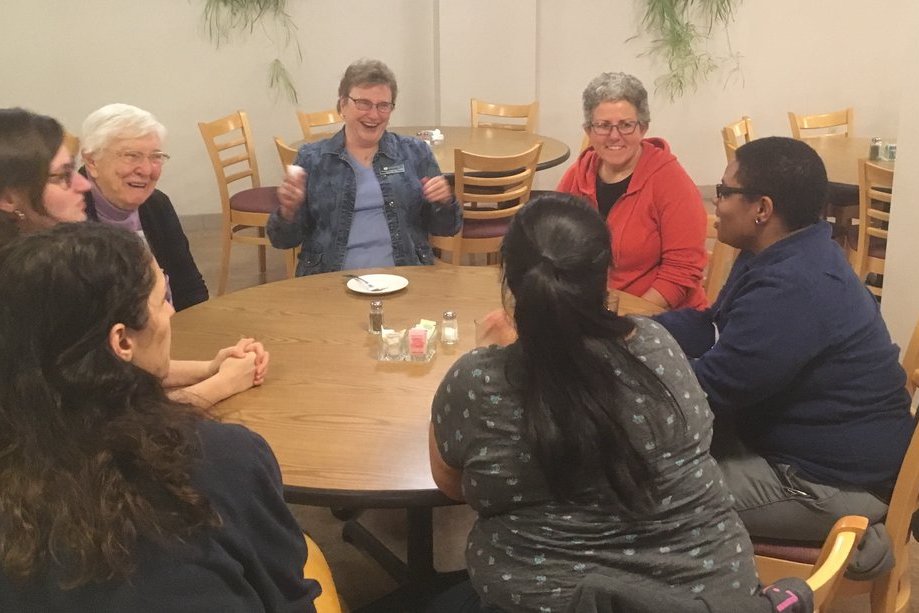
St. Louis Nuns & Nones gathering. Wherever the conversations went, gatherings tended to leave participants glowing with a new sense of connection and hope. At the end of a gathering in the Bay Area, one sister wrote: Such a magnificent community has been born, burst forth upon our world and universe....released and growing. I am in awe, and feel so drawn toward its Light and Love and Deep Union. I love the possibilities it holds for our continued engagement with each other. After Kalamazoo, one millennial shared: At a time when it is easy to feel disconnected and divided, our time together revealed and strengthened a network of authentic, emerging relationships. We are building a new community, a collective movement, working together towards peace and justice. And another sister: At the end of the gathering the world was more closely knit together. An energy had gone out that made community among diverse groups more possible than ever before. In St. Louis, 92 year-old Sr. Ida concluded with a mandate to all: “keep creating intentional communities!” 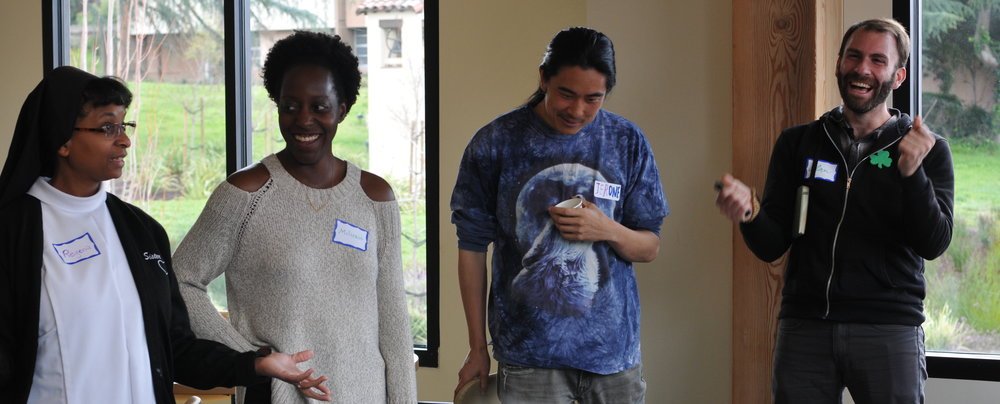
Laughter at a Bay Area Nuns & Nones gathering. Photo by the author. Over the months, as we went from site to site, it felt as if the conversation was evolving on its own—not just repeating, but growing and uncovering new possibilities with every circle. There’s surprisingly little scripture spoken aloud at these gatherings. Indeed, the Jews seem to bring up Jesus more than the Christians. But there is one line that is spoken by a sister at almost every gathering: “Behold, I am doing something new. Do you not perceive it?” (Isaiah 43:19) We are all still listening for what this new thing is. But some clues are emerging. As congregations grow in age and dwindle in numbers, sisters have transitioned much of their institutional infrastructure or “ministries” to lay leadership. In doing so, they’ve become practiced at the art of letting go, freeing themselves up to respond to new calls to action, while finding ways to ensure that the mark of their charism remains in the hospitals, schools, and nonprofit organizations they’d started. The Nuns & Nones conversations are revealing another critical institution that hasn’t received as much attention or care in transition, yet is among the most worthy of legacies to pass on and reimagine together: sisters’ extraordinary way of life and the institution of community itself. It’s not surprising that this way of living and serving in community hasn’t received the same kind of attention that the external ministries have; it’s the air that sisters breathe, the water they swim in. It’s also one of the prophetic aspects of religious life that, especially in this era of privatization and hyper-individualization, most powerfully speaks to the yearnings of a younger generation looking to live differently. Although new sisters aren’t joining in the numbers they once were, this is a critical moment to explore new modes of charism transmission and to support a younger generation in stepping into committed community lives of contemplation and shared social action. Reading the signs of the times and walking together, we are beginning to hear a common call to help incubate new forms of community rooted in love and committed to justice. The pillars of these new forms of community may not be so different from what has helped hold religious life in place for hundreds of years. As we walked among two-hundred year-old olive trees and lovingly tended gardens at the Dominican Motherhouse in Fremont, California, Sr. Gloria Marie Jones explained to me the four organizing principles of her community: study, prayer, shared life (community), and ministry (work in the world). As someone constantly looking for time-tested frameworks by which to structure a life, this elegant simplicity was a welcome offering and resonated on a deep, intuitive level. I too was looking for a life of learning, contemplation, community, and healing work in the world. Like the Dominicans who take seriously the mandate to “read the signs of the times” I aspired to make my work not about having a career in some sector, but about listening and responding to the call, co-creating in response to the needs of the time. Part of what kept me so engaged that first year was realizing just how much personally applicable wisdom sisters had to share—and how joyful it was to forge these new friendships. 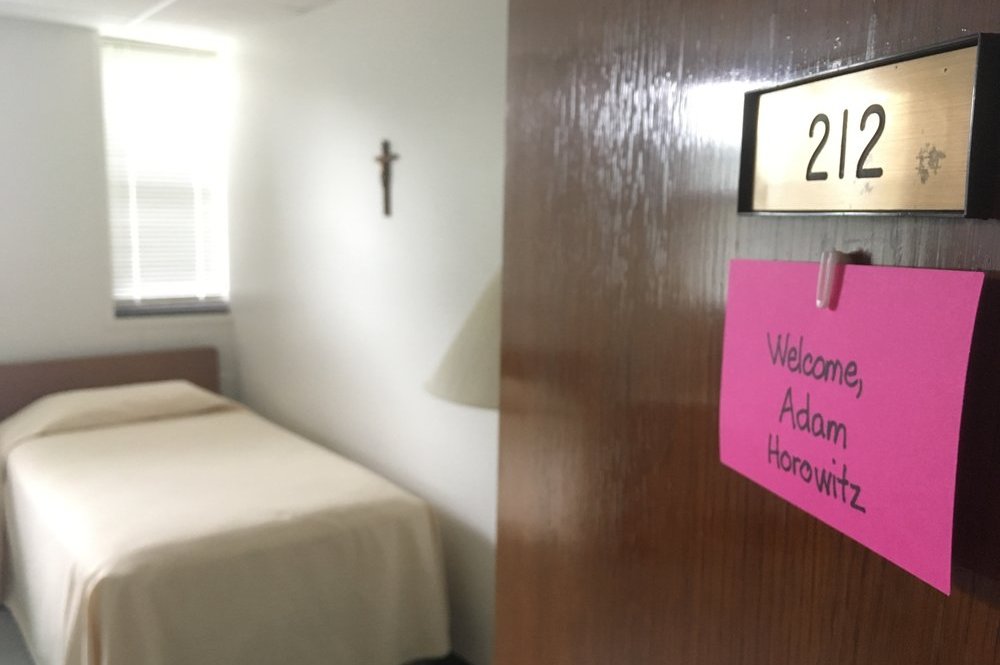
Another day, another convent. Visiting the Dominican Sisters in Springfield, Illinois on a cross-country roadtrip. Photo by the author Over the course of 2017, the “S” section of the contact section of my phone filled with Sisters; I amassed literature and visitor passes from dozens of communities; and there were months in my itinerant life where I woke up in convents more often than anywhere else. All the while, I was continuing a full-time job, attempting to keep another organization afloat. I was drawn to the lives of women religious, in part, because of that ideal of balancing action with contemplation, in community. Meanwhile, I was driving myself to the brink of burnout, as was Wayne. Reading quotes from Thomas Merton aloud at gatherings in late 2017, the irony was not lost upon us: “There is a pervasive form of contemporary violence to which the idealist most easily succumbs: activism and overwork. The rush and pressure of modern life are a form, perhaps the most common form, of its innate violence. To allow oneself to be carried away by a multitude of conflicting concerns, to surrender to too many demands, to commit oneself to too many projects, to want to help everyone in everything, is to succumb to violence. The frenzy of our activism neutralizes our work for peace. It destroys our own inner capacity for peace. It destroys the fruitfulness of our own work, because it kills the root of inner wisdom which makes work fruitful.” We were were moving at an admittedly frenzied pace. Never mind the fact that Wayne had written a book on the Sabbath and regularly did workshops on slowing down, and I was completely fried from running a nonprofit organization, desperately seeking a different pace and ground of being. We found ourselves exchanging midnight emails and zipping around to convents. The road to and from one gathering might have even involved fast food and speeding tickets. Oy vey. Less than twenty-four hours after Wayne had a heart attack at a gathering in the Bay Area (unbeknownst to both of us at the time, and a longer story), he was plunking out the Beatles “Mother Mary” on an upright piano at the convent, singing: When I find myself in times of trouble, Mother Mary comes to me Speaking words of wisdom, let it be And in my hour of darkness she is standing right in front of me Speaking words of wisdom, let it be Let it be, let it be, let it be, let it be Whisper words of wisdom, let it be We knew the pace of our extracurricular efforts was a bit much. But we both carried an almost embodied sense of how timely and sacred the window of time was to make these connections. It was hard to just “let it be.” At the very least, we wanted to help tee up the conversations, and then let be whatever wanted to emerge. *** January 1st, 2018 was the first day I woke up not knowing where I would be staying that night—or the following night, or the next week, or month. Blessed with many caring connections among friends and family, I was grateful to feel home-ful, not homeless. It was the beginning of period in which I had to develop a new level of trust and a willingness to be in some free fall, untraining my perceived need for certainty and stability. During those first months of 2018, I experienced a kind of intuitive flow that I’d never before felt—along with some deep exhaustion. One of the unexpected places of hospitality and respite for two weeks during that time was Mercy Center. Nuns & Nones soon expanded beyond the initial gatherings, taking on new life through a rich web of relationships. In the Bay Area, the group continued to meet over weekend-long retreats at motherhouses, where we’d stay up late in conversation, millennials and sisters both, sharing glasses of wine, wondering about the possibility of co-creating new charisms, singing Leonard Cohen’s Hallelujah, accompanied by guitar. Folks organized field trips to tiny homes, places of ministry, and other intentional communities. Sisters and millennials began meeting up, one on one, to deepen relationships. The group in Grand Rapids continued its biweekly meetings. Christina Tran started hosting monthly online video calls for the growing network. And I couldn’t help but talk about nuns wherever I went, piquing the curiosity of friends, more of whom began to get involved. One evening a group of us dropped by the Sisters of Mercy for dinner on the way back from a meeting. After an evening of laughter and story sharing, we all wrote haikus. Sr. Janet Rozzano’s was especially memorable: Eeek! What will I say? I’m too old for millennials! Surprise – they’re soul mates. Stories about Nuns & Nones began popping up in the Catholic press. (Based on Sr. Janet’s haiku, “Soulmates” later became the title of the cover story about Nuns & Nones in U.S. Catholic Magazine.) We started hearing from sisters all across the country interested in starting Nuns & Nones groups. While the enthusiasm was there, our organizing capacity wasn’t. 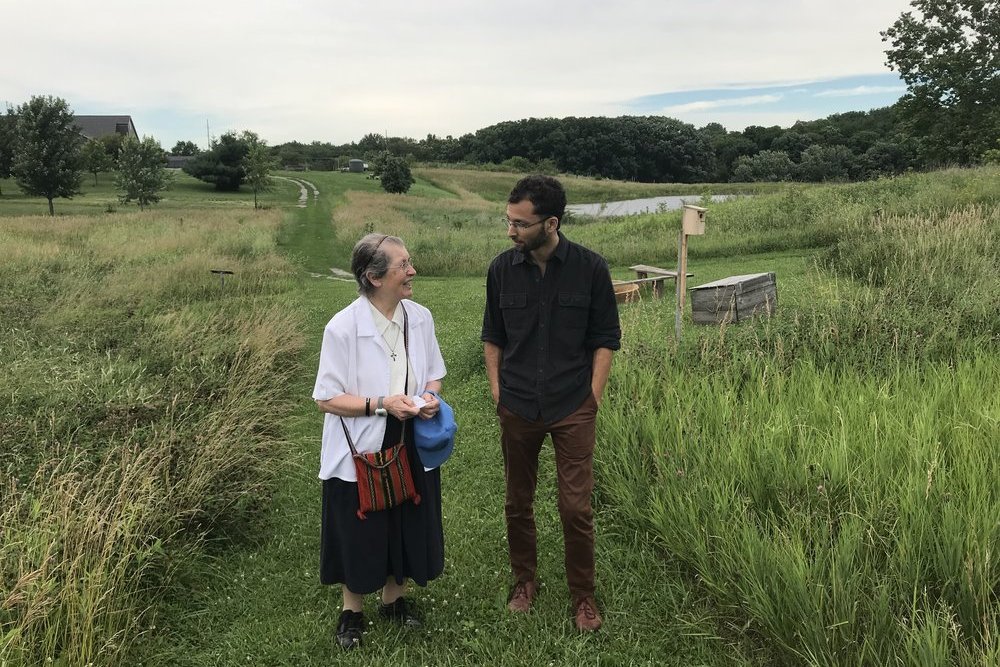
Walking with Sr. Mary Clare Fichtner, OP, at Jubilee Farm, an eco-spirituality farm and center, run by the Dominican Sisters of Springfield, Illinois. Photo by Alan Webb Over the summer of 2018, dear friends Alan Webb and Brittany Koteles set off on a roadtrip to 11 motherhouses in the Midwest. I drove with Rachel Plattus and Emily Chiapinelli from Connecticut to St. Louis, stopping at communities of women religious along the way. Sr. Eileen Dooling at Mercy by the Sea in Madison, CT showed us the open field in which she’s been dreaming of starting a community of tiny homes and gardens. Sr. Liz Langmead from the Mission Helpers of the Sacred Heart showed us around her nearly empty convent in Towson, MD. One of her community’s primary ministries has been providing asylum for refugee women. Now only a few sisters are left living in the convent, with the capacity for dozens more. Imagine the win-win-win potential of sisters with the wisdom and practical experience of providing asylum, the physical space to do so, and a younger generation eager to live in community and to be of service. Every visit revealed beautiful collaborations just waiting to happen. After dinner one evening with the Dominican Sisters of Peace in Columbus, Ohio, Sr. Pat Twohill informed us that she’d asked her communications team to show up in the morning with a video camera. She then fired off an email to a few sisters asking them to meet us at 9 a.m. shoot—another glimpse of how quickly and effectively women religious leaders can call on their communities. At breakfast, Sr. Angelica expressed the hope that they would find new ways of spreading the Dominican charism, a way of life oriented around “sharing the gifts of our contemplation.” And then, we headed into a room where a camera crew was getting set up. We had all of five minutes to meet these wonderful sisters before lights were on and cameras rolling. Far from the two-day gatherings we were used to, this brief get-together still gave us all a glimpse of the possibilities amongst us. Throughout all of this we were wondering how to move into deeper relationship, beyond occasional conversations and visits, to something more. There was a growing sense that the more we leaned into authentic, mutual relationship, the deeper the field of listening could become, and the more possible it might be to activate the healing and liberatory potential of these connections. Seeking the next step, I drafted a call for a “pilot residency,” in search of a community of women religious who might feel called to open their doors for a bounded period of time to a group of younger seekers with a commitment to similar values and work in the world. By living in community together, might we begin to uncover new ways to future the charism and to carry on important social justice work? Could we model, in one or two sites, some new way of collaborating across generations and faith traditions to meet the needs of our times? We circulated the call among sisters we’d met since the first gathering, curious to see if it would spark any interest at all. Inviting younger folks across genders and faith traditions into a community of women religious would indeed be a bold leap of faith. But there has been a stream of movement in this direction for decades. At a sidewalk book sale in Philadelphia, I happened upon a copy of a 1996 book by Sr. Barbara Fiand, “Where Two or Three Are Gathered.” To my surprise, it contained an especially poignant vision for the future of religious life, drafted jointly by the LCWR and the Conference of Major Superiors of Men. In 1989, these important leadership bodies envisioned “transformative elements” of religious life and wrote: “Religious in the year 2010 will serve a prophetic role in the church and society. They will live a spirituality of wholeness fostering: participation and harmony among all people, healthy personal and interpersonal relationships, reverence for the earth, integration of spirituality and technology on behalf of the gospel. Their communities will be characterized by inclusivity and intentionality. Our communities may include persons of different ages, genders, cultures, races, and sexual orientation. They may include persons who are lay or cleric, married or single, as well as vowed and/or unvowed members…Our communities will be ecumenical, possibly interfaith: faith-sharing will be constitutive of the quality of life in this context of expanded membership. Such inclusivity will necessitate a new understanding of membership and a language to accompany it. Religious life still includes religious congregations of permanently vowed members.” Seeds for the kinds of experiments we were imagining with Nuns & Nones had been planted decades ago—by both women and men religious. But the gap between the articulation of possibility and its incarnation can be vast indeed. By the summer of 2018, we started to get signals that the Sisters of Mercy in Burlingame, CA were interested in possibly saying “yes” to a Nuns & Nones Residency. This made sense; relationships with these justice-oriented sisters were already warmed up from previous gatherings—and having spent two weeks there earlier in the year certainly helped. Suzanne Buckley, director of Mercy Center, was also one of our most energetic champions, keen to see something happen. Being the largest order of women religious in the U.S., in the midst of a national unification process, meant that moving forward with a pilot community with the Sisters of Mercy would require approval from the national leadership, in addition to local buy-in. Thus began several months of deliberation and dialogue with national leadership, spearheaded by Sisters Judy Carle, Judy Cannon, Joan Marie O’Donnell, and Patsy Harney. Meanwhile, I began circulating the possibility of the residency with some close friends and collaborators, in the Bay Area and beyond, who’d been a part of Nuns & Nones and previous journeys together. We too entered a process of discernment. Saying “yes” to rearranging our lives to spend six months in a convent in the suburbs would surely require a strong sense of purpose and trust. Many of us were in moments of transition, sensing the need to orient differently to work, spirit, and community. Compelled by the relationships we had already begun with these sisters and with each other, we found ourselves inching ever closer to a reality that, just a year earlier, would have struck each of us as completely far-fetched. After many moments in which it seemed like it might all fall through, the Sisters of Mercy in Burlingame finally got the green light from the national leadership in Omaha, Nebraska. In September 2018 we learned that our 6-month “pilot residency” would begin in just two months. Five millennials—two women and three men—were on board. The weeks leading up to our arrival at Mercy Center felt like the lead-up to the launch of a spacecraft. We were all, sisters and millennials alike, astronauts who, unbeknownst to us, had been preparing for this mission for years—unaware of our future co-pilots, until now. We weren’t under the illusion that it would be an easy mission, or particularly comfortable in outer space, or inner space, or wherever we were headed on the far frontiers of religious and community life. But I believe we all shared the sense that sometimes you have to go out there for some new perspective, so as to uncover and report back a different story about what’s possible. 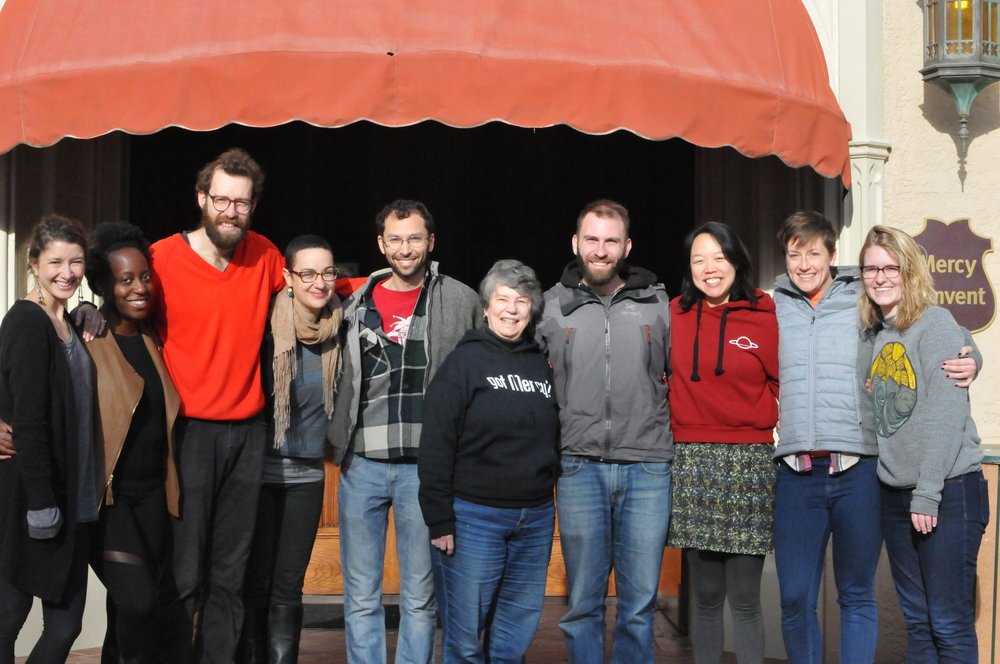
Nuns & Nones pilot residents and visiting collaborators stand outside of Mercy Convent in Burlingame: Sarah Bradley, Milicent Johnson, David Bronstein, Rachel Plattus, Adam Horowitz, Sr. Judy Carle, Alan Webb, Christina Tran, Brittany Koteles, and Katie Gordon. *** Mercy: Week One We didn’t have air masks—and even if we did they wouldn’t have worked for those of us with beards. (We learned from a sister who had been fitting masks for folks at a nearby hospital that people with facial hair need full-on “hoods” to prevent particles from getting in.) So, we spent most of that smoky first week at Mercy inside our quarters. The side of the building we live in is the former Novitiate, where women entered, often in their mid-to-late teens, to begin the six-year journey toward taking final vows. The timeline of this wing tells a story that resonates across orders of women religious. It was built in 1964 to accommodate the growing number of women entering the Sisters of Mercy. Membership peaked in 1966, followed by a steady decline. By 1981, the wing was so scarcely inhabited that the sisters decided to repurpose this half of the building as “Mercy Center”—a spirituality and conference center with 90 bedrooms and a dozen meeting spaces, serving the needs of a broader community of nonprofit groups and spiritual seekers. We live along a fourth floor corridor, each in a small room outfitted with a twin bed, simple desk, closet, and sink. My north-facing windows overlook oak and eucalyptus trees and the hillside sprawl of wealthy suburban Burlingame. The commute to work is the three flights of stairs down to our shared office space, with décor meticulously curated by Sr. Suzanne Toolan, age 91, an internationally acclaimed composer and foundress of multiple nonprofit organizations. Not a single cross on the wall—and two images of Moses! A gesture of welcome to the two Jews among our group of five? At our informal welcome reception, the room was full and buzzing with sisters, staff, and other friends of Mercy. Over coffee and cookies, we introduced ourselves and met our generous hosts, getting a deeper feel for Mercy hospitality and the tradition of bridge-building that goes all the way back to Catherine McAuley, the foundress. Sr. Marian Rose Power welcomed us by lifting up a bag full ingredients—apples, sugar, and a pie crust—promising they’d return in the form of a warm apple pie when we called the phone number on the card addressed to the “Nones,” saying we were ready. Sr. Joan Marie O’Donnell read aloud a blessing she wrote for the occasion: Faithful guide of those who journey Take our hands as we walk the road Through the unnamed wilderness In search of the place of our belonging. Faithful companion, assure us of your presence In the foggy land of “I don’t know” and the “not yet”. Source of Wisdom and Guidance, Be the stay that leads us to the horizon of hope and new life. Shine truth onto our path And bless us as we move in new directions… And new directions we indeed embarked on. Although we almost never stepped outside that first week, it wasn’t too isolating. Peeling apples with Sr. Judy Carle, we learned about upcoming mergers of major healthcare systems and heard updates on the people in immigration detention centers that the community has been accompanying. At the Zendo on the ground floor we sat with Father Greg Mayers, a redemptorist priest and Zen Roshi. In the auditorium, we joined the celebratory final meeting of an interfaith coalition featuring reflections on solidarity and action from Muslim and Christian leaders, youth reciting from the Koran, and the Mercy High chorale. At the meeting, Sr. Carol Baetz, in her late 80s with sparkling blue eyes, shared that we are all one, but need to know that and feel that through direct experience and embodied action. We had the first of what would become our weekly Shabbat dinners with sisters, full of song, spacious sharing, and a homemade meal, complete with a challah covered in a dishcloth depicting nuns in habits. The challah was blessed, broken, and shared. Like our lives. Like the eucharist. We became com-pan-ions in the truest sense of the word, breaking bread together. I sensed a line of ancestors standing behind and above each one of us, watching on, smiling. What we had begun here was not a program, not a new curriculum in spiritual formation or interfaith community-building. Unlike the novices who’d entered this very same place decades before, our time would not be defined by hierarchical structures and rigorous rules, but by real-time inquiry and mutuality. We would make the road by walking, creating structures based on the needs and insights that emerged. Within just days we could feel how the sisters were creating a receptive, listening, and spacious container for whatever it was that we were all here to learn together. Any signal we put out was swiftly responded to. One day after I made a brief remark expressing a desire to learn more about the founding story of the Sisters of Mercy, a colorful shoebox full of carefully selected books and pamphlets appeared in our office with a note. When a visiting friend made it known that she was a weaver, sisters who weaved showed up at all hours of the day to connect with her. In the meantime, we began to explore our own spiritual practices and rhythms of sharing in community. The residency would be an opportunity to incubate our own version of intentional community, a laboratory of commitment in which to figure out what our expectations were of ourselves and each other—while also sustaining our work commitments in the world. What were our core values, and how would we create a structure to nourish them? On a personal level, it felt like these might finally be the conditions I’d been searching for to cultivate a different ground of being from which to operate when I left the residency six months later. The only day during that first week that I did leave the convent for an event in San Francisco, the discordant sites on a single street corner accentuated the apocalyptic sky from the fire in the north. Upon getting out of the car, I watched folks crossing the street wearing air masks, walking their leashed dogs with eerie normalcy. To my right, a half-clothed man draped in a blanket was swaying and talking to himself. To my left, five or six people (unmasked, and likely Central or South American) climbed all over a giant black SUV, scrubbing it by hand at a bustling car wash— all on a day where the sky was still a dark gray and there were more parts per million of carbon dioxide in the air in the Bay Area than in Beijing or Delhi. “This is what the end of the world looks like,”I thought to myself. Not some abrupt fiery finish, but this steady escalation of inequity, devastation from climate change, and loss of meaning and community, amidst continued attempts at business-as-usual. And yet it probably would have read as a fairly cheerful scene for the Sisters of Mercy who arrived to San Francisco in 1854, amidst terrible cholera and an influx of migrants who didn’t have access to basic services. Or in 1906, after the Great San Francisco Earthquake, when sisters rushed to aid create pop-up hospitals in tents around the city and to take in the homeless. To this day, nuns get free rides on public transit as a token of gratitude for their contributions to the city. I was glad to leave the city and return to the refuge of Mercy Center. I only wished we could have opened up space in this largely empty building for the hundreds displaced by fires raging nearby. 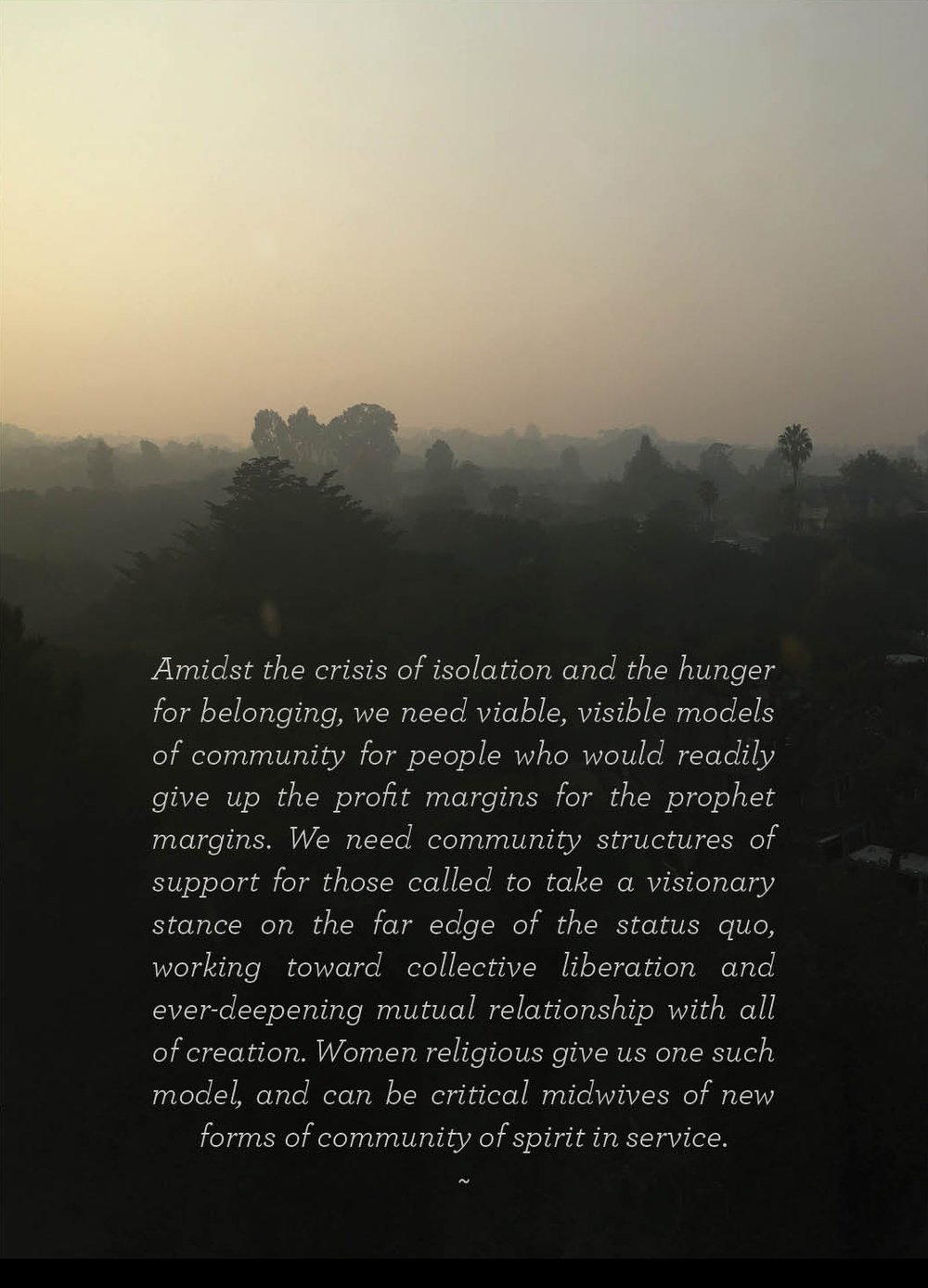
View from the bedroom window at Mercy Center during the California fires. Photo by the author. *** Refugia After fire ravages a forest, there are often small pockets of life, islands of green among the ash, which—almost miraculously—remain unharmed and intact. These areas, called fire refugia, shelter species that would otherwise be wiped out, becoming the seedbeds from which the forest regenerates. They don’t have to last forever to make a difference; even short-lived fire refugia can be the saving grace for local biodiversity. Scientists don’t know exactly how and why they occur, but they are essential to life after destruction. If we were able to somehow map them, understand how they work, and develop a strategy for preserving them, “that would be sort of the Holy Grail,” according to one biologist in a recent New York Times article. We may not yet be able to understand and nurture these ecological refugia, but we can work to preserve and create the spiritual, cultural, and civic refugia needed in these times. Amidst catastrophic climate change and vicious economic inequity wrought by centuries of patriarchy, white supremacy, capitalism, and settler colonialism, we are in dire need of what we might call refugia communities, working across generations, cultures, and faith traditions to create new seedbeds from which life can flourish. Of course, myriad versions of refugia communities already exist all around us in the form of neighborhoods where people truly know and care for each other, mutual aid societies and networks, faith groups and religious communities offering sanctuary, intentional communities with open doors, cultural centers keeping traditions alive, schools that nurture whole humans, land-based centers practicing sustainable agriculture and earthcare, democratically-governed worker-owned cooperatives looking out for the wellbeing of all. We can’t know what the future holds—though recent UN reports on climate change offer harrowing clues. But we do know that the challenges coming our way will need to be met by communities, not individuals. At a moment when the hunger for community is so palpable—across people of all ages and backgrounds—what might it look like to more intentionally, collectively take on the task of creating refugia communities that are intergenerational, intercultural, spiritually grounded, and socially engaged? How might such communities help nurture the moral and spiritual capacities required to both grieve and live courageously amidst planetary destruction? How might they practice and spread a culture of embodied hospitality and sanctuary in the face of devastation and displacement? Monasteries emerged during the Dark Ages as places to steward wisdom traditions amidst societal disarray. What if, in this age, we are called not to create isolated sites of contemplation and study, but, rather, communities of spirit in service—in plain sight? Urban monasteries, Houses of Belonging, engaged intentional communities, and reimagined forms of “religious life” dedicated to creating the conditions in which we can become more human humans, bring our creative capacities to healing and tending the earth and one another, step outside of extractive systems, and steward, renew, and pass on wisdom traditions. 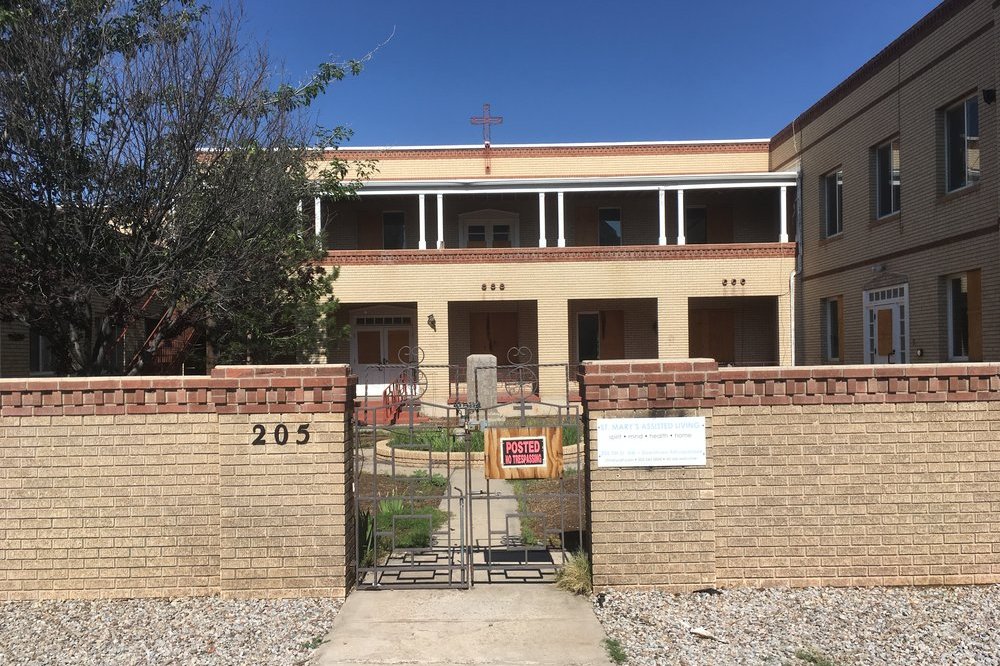
An empty former convent in Albuquerque, New Mexico. Photo by the author. Given the opportunity, the right structures, might there be untold millions who would forgo the almost religious pursuit of wealth in favor of a more humble and grounded life of meaning-making and tikkun olam—Hebrew for healing of the world—in community? Might we imagine and create new kinds of “orders” to meet that yearning? Amidst the crisis of isolation and the hunger for belonging, we need viable, visible models of community for people who would readily give up the profit margins for the prophet margins. We need community structures of support for those called to take a visionary stance on the far edge of the status quo, working toward collective liberation and ever-deepening mutual relationship with all of creation. Women religious give us one such model, and can be critical midwives of new forms of community of spirit in service. Based on decades of experience living in self-governing, women-led, resource-sharing, justice-oriented, spiritually-rooted, risk-taking, “counter cultural” communities of contemplation and action, sisters have a wealth of wisdom to share with a younger generation setting out to serve and heal in a fractured world. Through Nuns & Nones we are seeing that sisters’ charisms have natural inheritors in a younger generation of seekers. In building these bridges and relationships, might we enable a continuation and transformation of religious life that—far from being an ending or a “diminishment”—is part of the birth of a new wave of prophetic communities? In her 2018 presidential address at the LCWR’s annual assembly, Sr. Teresa Maya spoke about the critical call to nurture community: “Our mission as leaders for this time is as simple as it is ancient: community. This is what we do best; this is what we have always done through all our ministries. We lead for community. There is nothing more important, more radical, more necessary for us than to lean into our apostolic call to nurture and foster community wherever we find it, wherever we are, with whatever means we have, whether it is prayer, solidarity, presence, sponsorship, or our blessing…. Pope Francis reminds us in his most recent exhortation that “no one is saved alone.” Eruptions and disasters require community. Preparedness for what is coming needs to be done in community. The only way for us to hope in this moment in time is as community: Hope is the gift of communion.” How might sisters and millennials, along with allies across generations and faith traditions, work together to create the refugia communities needed now and in the decades ahead? How might we nurture and incubate new communities that themselves share the call to “foster community wherever we find it?” Communities that prioritize our common humanity over divisive dogma and that heed the call to “do justice, love tenderly, and walk humbly with your God,” whoever that God may be. The unfolding work of Nuns & Nones will take many forms, with groups of women religious and younger folks within—and outside of—many faith traditions finding next steps rooted in local contexts and relationships, uncovering place-based possibilities that can’t be dreamed of in the abstract. But, just to spark imagination and point to some of the many paths forward… Imagine “pilot residencies” of younger organizers and activists, intentional communities in the making, living and learning alongside communities of women religious across the country (or world). Communities could issue charism-specific invitations, partnering with younger folks who are called to the same issues that women religious have been working on for years, from climate justice to immigration to racial justice. Residencies could also focus on spiritual formation and serve as apprenticeships in prophetic community, preparing groups to form new place-based communities of spirit in service. Imagine residencies that go beyond six months and actually become some new kind of covenantal community. Imagine empty convents filled with visionary new communities of spirit rather than being sold on the speculative market, carrying on the charism through justice work and community-building. Envision the community gardens and permaculture projects that could come to life on otherwise empty land, through new partnerships. Think of all of the alumni of service corps programs—Jesuit Volunteer Corps, Mercy Volunteer Corps, Quaker Service Corps, and dozens of others—who’ve already had transformative experiences living in community, deepening in spiritual formation, and being of service to the world, and are looking for a community that they can join for the next chapter of their lives. Imagine the generative capacity of wise elders, imaginative youngers, and underutilized space and land, in meeting the needs of the moment and preparing for the challenges that lie ahead: sanctuary for people displaced by economics, violence, or climate change; organizing and movement hubs; schools for spiritual formation; training grounds for street medics; seed libraries; staging grounds for new projects and enterprises that create meaningful livelihoods for people outside of the structure of extractive capitalism. Imagine a visionary cross-generational team of sisters and allied partners with relevant expertise—on everything from community land trusts, to cooperative organizational development, to restorative justice, permaculture, and theology—available to support with the needs and dreams of various communities in transition and transformation. 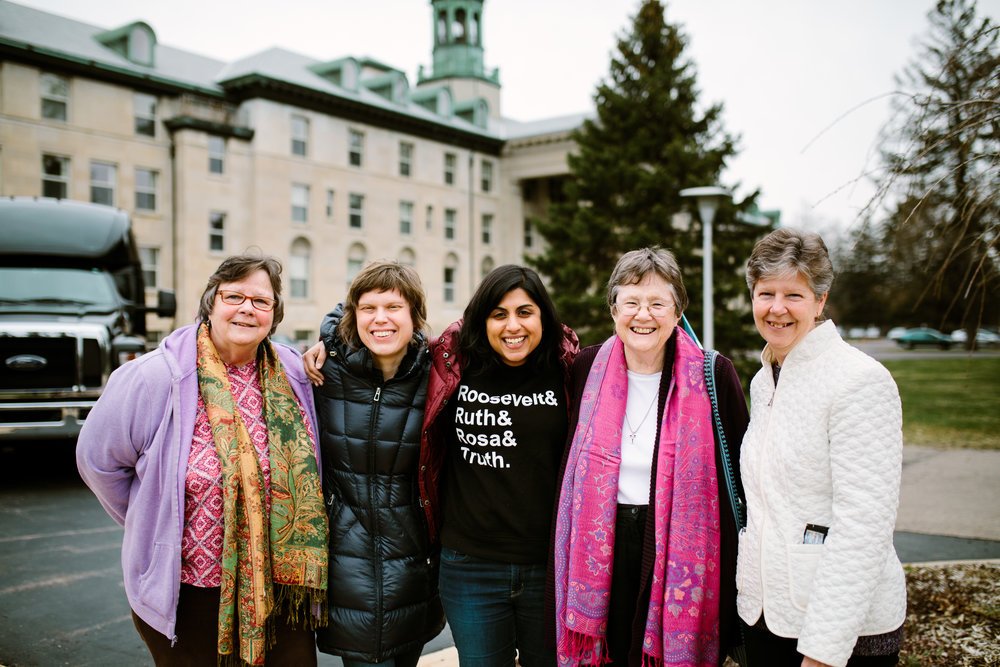
Sr. Liz Langmeade, MSHS, Rebecca Parrish, Priya Parrish, Sr. Mary Trainer, RSM, and Sr. Annmarie Sanders, IHM, at a tour of the Sisters of St. Joseph Motherhouse in Kalamazoo, Michigan. Photo credit: Rhino Media When social or environmental crises arise and an “all call” goes out to sisters to take action or to send community members—as recently happened at the border—imagine a “nun plus one” program, where younger folks could journey with sisters, accompanying and learning with them through action. Imagine a generation of younger organizers and seekers helping document sisters’ stories through oral histories, drawings lessons from their decades of humble activism and life in community. And imagine all of this approached with a lens of healing justice, an action-oriented awareness that the wealth that has enabled so much of this country’s civic, social, and religious infrastructure is rooted in histories of enslaved labor, violently enforced assimilation, and stolen land. Imagine these new communities actively engaged in the work called for in the Movement for Black Lives policy platform and by Indigenous rights activists. Native reservations currently occupy just 2% of the land promised in the original treaties. What does that mean in the context of land transition and at a moment in which we desperately need the environmental and cultural wisdom embedded in practices of indigenous land stewardship? Throughout her speech, Sr. Teresa Maya returned to a central image and metaphor very akin to fire refugia. She spoke of religious life approaching a spectacular finale, like a volcano erupting, and reminded sisters that amidst the ashes and lava, new life can grow: Ultimately, the task of our leadership is to make the color real for our communities! Leadership must vision beyond the preparation for the final eruption. We need to point to the wildflowers already showing up among us. We need to encourage the belief that the wildflowers can grow from the ashes… We have a few good years to bless the next generation with our wisdom and our trust, to kindle in them the hope of God's vision for humanity...our time in leadership will not be complete until we have called all of our sisters to share the Why of their extraordinary lives… Our nuns, our sisters, our communities need to go forth into these conversations with the 'nones.' I have hope in the conversations being convened by the Nuns and the Nones movement. This is a rare and precious moment, a kairos window for charism transmission and social transformation, rooted in mutual respect, deep listening, and authentic relationship. In a society in need of new models of intergenerational exchange and eldership, sisters can be natural and valuable companions and mentors for new communities and projects seeking to give birth to ways of being and thriving, outside of an extractive, capitalist society. From the ashes of the volcano, we can spark a social and contemplative movement that takes as its building blocks a different architecture of community, figuratively and literally—that counters atomization, division, and the privatization of love through communality, prophetic imagination, and robust rhythms of action and contemplation. To launch this regenerative arc of new prophetic communities, we must gather our collective breath to blow on the embers while they are still hot. With religious communities aging and making critical decisions about their futures, we are called to live into the paradox of a moment in which there’s too much at stake to rush—or to wait too long. We must proceed with thoughtful care and take bold leaps. We must move at the speed of trust and with the fierce urgency of now. Throughout the Nuns & Nones journey I’ve caught glimpses of what it looks like to do just that. In our circles of listening and co-creation, there’s been space enough for like-hearted sisters and millennials to build bonds of trust and care—and then to invite trusted peers along for the journey. Together, we quicken the pace of collective possibility when we invite along the friends with whom we’ve been building trust for years—before this particular calling. We widen the field of grace when we warm it up with the relational trust accrued over time. Showing up fully to nurture the possibilities of this moment will also require financial resources, organizational structures that nourish authentic relationship, and focused awareness. Something is happening organically, but time is of the essence and, as one sister put it, “we can always make a little more space for Spirit to move in.” Making “a little more space” means investing in the bridge infrastructure through which these new possibilities can take shape, shifting narratives in religious life from diminishment to renewal and transformation. Communities that are inspired by these possibilities can bring all kinds of resources—money, time, expertise, space—to the table in support of emergent visions. Line items that might once have been allocated for the novitiate, for example, might be reallocated for organizers and programs supporting new forms of charism transmission and community formation. Working together, religious communities, millennial organizers, and allied philanthropic and thought partners, can create a just-in-time ecosystem of support for regenerative transition, transmission, and transformation. The kinds of ideas set forth here are not the only ones emerging from Nuns & Nones, nor are they posited as the future of religious life. They represent one direction to move in, among many others. In times of great change and uncertainty, when the end of the world as we know it feels close at hand, we need both the wisdom of elders and the imagination of youth to keep finding paths forward. Together, we can contribute to the “revolution of tenderness” that Pope Frances has called for, creating refugia communities that help make the revolution appealing, even irresistible. 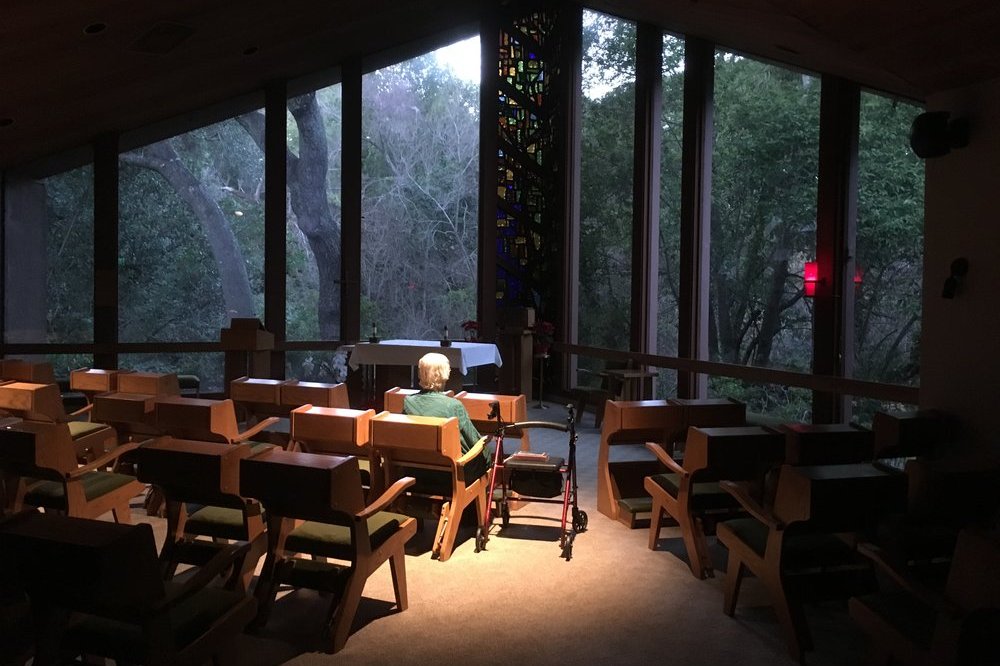
Sr. Pat Ryan, RSM, at the chapel in Marian Oaks, the assisted living center for Sisters of Mercy in Burlingame. Photo by the author. *** We Give Thanks Thanksgiving Day lived up to its name, as we all woke with gratitude to the first day of blue sky and fresh air since our arrival. Eager to get outside before joining the sisters for a feast at noon, I threw on a coat and climbed the hill, past Burlingame’s fancy homes, big cars, meticulously landscaped lawns, toy drones, and up to a nature reserve with moss-covered elms twisting alongside a babbling creek. At an outcropping that might once have been a lookout, one can see into the San Francisco Bay and watch planes land at nearby SFO. This must have been a fertile valley for the Ramaytush Ohlone, its original inhabitants, and the people especially on my mind this day. Everything had a new vibrancy now that the smoke had cleared. Able to smell the plants again and get lost in their colors, it felt as if I’d finally arrived, one week after showing up. At noon, three of us “Mercy Millennials” walked over to Marian Oaks, the assisted living center for sisters on campus, and were greeted by Sr. Lillian Murphy, who spent 27 years as the CEO of Mercy Housing (which now serves 72,000 people in 42 states). The women living here may be more elderly and frail, but get them telling stories and Mercy spunk and zeal are on full display. A priest once remarked that the Burlingame Mercies were like “locomotives dressed in velvet,” a description sisters must have felt was accurate enough to let it stick. Some of the older sisters, in particular, blend a no-nonsense get-things-done sensibility with an air of sophistication and class. We enjoyed a classic Thanksgiving feast in the dining room and, prompted by Sr. Judy Carle, one of our main host sisters, introduced ourselves and offered up a song of thanks: We give thanks, for unknown blessings already on their way. We give thanks, for unknown blessings already on their way. We will not look back in anger. Or forward in fear. But around in awareness. The sisters responded together with a song of their own, voices soft and high: Where charity and love are there is God. The love of Christ has gathered us together Rejoice, rejoice and be glad. When therefore we assemble Let us be of one mind … Let Christ our God Our God dwell in our midst. Over the following weeks, our makeshift community of five resident millennials began to explore what it meant to assemble and try to “be of one mind” in community decisions and rhythms, while also following our own paths. The more time I spend in convents, the more I feel called to deepen in my study and practice of Judaism. (These past two years have also been full of rabbis!) And, the more time I spend with both sisters and rabbis, the more I feel invited into the study and embodied or experiential awareness of the mystical truths at the core of all religious traditions. I’m grateful to have been exposed to enough Christian mysticism, for example, to hear in that Thanksgiving song a theology of profound interdependence, non-duality, and unifying love. Coming back late one evening from a Chanukah party in Oakland, we met a receptionist at the front desk who we hadn’t seen before. She was thrilled that we’d returned late enough to coincide with her shift; she’d read all about us and was excited to chat. “So, are you thinking of becoming a priest?” she asked me. “No…” I shook my head, not sure how else to respond. “Oh, a rabbi?” she tried again. “No, I don’t think so,” I responded, and hesitated. “But maybe a Brother,” I shared, looking at my comrades, not entirely sure of what I meant, but feeling some truth to the statement. Eli Feghali and Sr. Celeste Marie Nuttman, RSM, carry on the conversation after a salon on the vow of chastity at Mercy Center. Photo by Alan Webb. Eli Feghali and Sr. Celeste Marie Nuttman, RSM, carry on the conversation after a salon on the vow of chastity at Mercy Center. Photo by Alan Webb. In mid-December, we were invited to the chapel for a Foundation Day service, commemorating the founding of the Sisters of Mercy. Every year, Mercy sisters around the world mark this occasion and collectively renew their vows. Unlike mass or Christmas or Thanksgiving, this was a particularly intimate celebration for the community. The lights in the chapel were low and the candles lit. Only the first few rows of pews were occupied. Alan, a fellow millennial resident, and I were the only men in the room—and probably the only people under the age of 60. Everyone else was either a Sister of Mercy or an Associate (the term for lay folks who’ve made a special commitment to accompany the sisters). Expertly accompanied by Sr. Suzanne Toolan on the piano, a community choir of tender voices lifted and echoed in the vast chapel. One by one, different women took to the podium to read reflections on this day, celebrating their foundress and the women who went before them: “For 175 years, by the tender Mercy of our God, the sisters have brought their hearts to misery from Pittsburgh and to points near and far flung… Casting the fire of mercy in places of poverty, sickness and ignorance. They have served in prisons and schools, hospitals and parishes, shelters and immigration centers. They have offered their simplicity, their hard work and their tender courageous voice for justice… They have poured themselves out in simple delight and patient suffering and cherished the union and charity that is a most prized legacy. Through the Grace of God, the Sisters of Mercy knew the mystery of growth and diminishment. And trust in a future full of hope…. Therefore, today, God continues to speak to the heart of our community, calling us to contemplate the presence of the Holy in a discordant world, to discover anew the seeds of God’s promise as fire in our hearts… To let the fire surge in us with new energy, we are called to embrace a revolution of tenderness! Therefore we proclaim this day with joy and thanksgiving.” No priests, no dogma, not even scripture. But a community of strong women renewing vows to one another and to their sacred call—with words that were also being sounded at services throughout the twelve countries represented by the Institute of the Sisters of Mercy of the Americas: “What, then, should be said of us and of our intentions for the future of Mercy? Our outreach will bear little fruit unless we see that every project that we engage in today continues to be done with the same hopes and dreams of Mother McAuley in mind. As Sisters of Mercy, as Associates and our partners in ministry we must remember what motivated Mother Warde and those who followed her. We must recall their passion.” I felt privileged to witness this precious moment, held by and for women who have done so much for the world, and whose stories may never be fully told. What would this service look like in ten or twenty years? What would Mercy look like in another 175 years? In some ways, it didn’t matter. There was deep “trust in a future full of hope.” We were invited downstairs to join for a celebratory meal in the dining hall. The large portrait of the Virgin of Guadalupe was decorated with bright paper flowers for the occasion. Foundation Day brought Mercy Sisters from around the region back together at the Burlingame Motherhouse, and the room was abuzz with a cheerful, familial din. I’d only been here for a month, but somehow, I was part of that family. As we stood in the buffet line, I exchanged hugs with sisters I knew and with others I was meeting for the first time. “Thanks for inviting us to join you tonight,” I said to a sister in line. She responded with a smile. “We’re glad you’re here, Brother Adam.” Through the extension of hospitality and kindness, we make one another kin. And in doing so, we risk transformation; we invite and embrace the god of change and the possibility of new life. What that new life will look like, for me, and for fellow travelers, peers and sisters both, is not yet known. Think of this, then, as a dispatch from the chrysalis—a story of transformation told in the middle of living it. Consider this, too, as an invitation to join in the unfolding. Embarking on this residency at Mercy Center, my peers and I have not “left the world behind.” Like the sisters, we are tending, daily, to organizations, movements, people, and communities far beyond these walls. But it does feel like we have walked out of one way of being in the world, without yet knowing what we will be walking on to. To know that we are not alone in this journey makes all the difference. To share these in-between times with women religious is among the most surprising, mysterious, and deeply nourishing gifts of my life. Facing uncertain futures, each and all, we accompany one another in friendship and care, forging the sacred trust from which a new story can be born. To learn more about Nuns & Nones and to sign up for organizational updates, visit www.nunsandnones.org. To sign up for occasional personal updates and future pieces of writing—or to be in touch directly—click here. |
|
|
| The text being discussed is available at http://www.adamhorowitz.org/convent and |
|
SITE COUNT< Blog Counters Reset to zero January 20, 2015 | TrueValueMetrics (TVM) is an Open Source / Open Knowledge initiative. It has been funded by family and friends. TVM is a 'big idea' that has the potential to be a game changer. The goal is for it to remain an open access initiative. |
| WE WANT TO MAINTAIN AN OPEN KNOWLEDGE MODEL | A MODEST DONATION WILL HELP MAKE THAT HAPPEN | |
|
The information on this website may only be used for socio-enviro-economic performance analysis, education and limited low profit purposes
Copyright © 2005-2021 Peter Burgess. All rights reserved. Last modified 04/07/2025 18:37:10 | ||